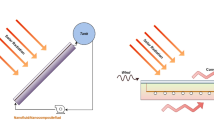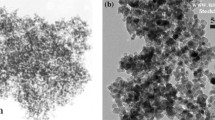Abstract
Thermodynamic performance analysis is carried out on a flat plate solar thermal collector utilizing single and hybrid nanofluids. Fe2O4/water, Zn-Fe2O4/water hybrid nanofluids, and water are used as heat transfer fluids, and their performance is compared based on the energy and exergy transfer rate. The thermo-physical properties are evaluated by regression polynomial model for all the working fluids. Developed codes in MATLAB are created to solve the collector’s thermal model iteratively, energy, and exergetic performance. The system is then subjected to parametric investigation and optimization for variations in fluid flow rate, temperatures, and concentrations of nanoparticles. The findings show that utilizing Zn-Fe2O4/water hybrid nanofluids with a particle concentration of 0.5% enhanced the solar collector’s thermal performance by 6.6% while using Fe2O4/water nanofluids raised the collector’s thermal performance by 7.83% when compared to water as the working fluid. The maximum energy efficiency of 80.1% is attained at the mass flow rate of 0.1 kg/s. The hybrid nanofluids have also given a maximum exergetic efficiency of 5.36% and an enhancement of 8.24% compared to Fe2O4/water nanofluids. It evidences that the hybrid nanofluids would become a better thermal alternative for water as well as single nanofluids.









Similar content being viewed by others
Data availability
Data will be made available upon request.
References
Abbasi S, Zebarjad SM, Baghban SHN, Youssefi A, EkramiKakhki MS (2016) Experimental investigation of the rheological behavior and viscosity of decorated multi-walled carbon nanotubes with TiO2 nanoparticles/water nanofluids. J Therm Anal Calorim 123(1):81–89
Alagumalai A, Qin C, Vimal KEK, Solomin E, Yang L, Zhang P, Mahian O (2022) Conceptual analysis framework development to understand barriers of nanofluid commercialization. Nano Energy 92:106736
Bellos E, Tzivanidis CJD (2018) Thermal analysis of parabolic trough collector operating with mono and hybrid nanofluids. J Sustain Energy Technol Assess 26:105–115
Bianco V, Chiacchio F, Manca O, Nardini S (2009) Numerical investigation of nanofluids forced convection in circular tubes. Appl Therm Eng 29:3632–3642
Bianco V, Manca O, Nardini S (2011) Numerical investigation on nanofluids turbulent convection heat transfer inside a circular tube. Int J Therm Sci 50:341–349
Bobbo S, Fedele L, Benetti A, Colla L, Fabrizio M, Pagura C, Barison S (2012) Viscosity of water based SWCNH and TiO2nanofluids. Exp Thermal Fluid Sci 36:65–71
Brinkman H (1952) The viscosity of concentrated suspensions and solutions. J Chem Phys 20(4):571
Chakraborty S, Panigrahi PK (2020) Stability of nanofluid: a review. Appl Therm Eng 174:115259
Choi SU, Eastman JA (1995) Enhancing thermal conductivity of fluids with nanoparticles. Argonne National Lab, Argonne
Das SK, Putta N, Thiesen P, Roetzel W (2003) Temperature dependence of thermal conductivity enhancement for nanofluids. J Heat Transf 125:567–574
Duffie JA, Beckman WA (2013) Solar engineering of thermal processes solar engineering. John Wiley & Sons Inc, Hoboken
Esfe MH, Saedodin S (2015) Turbulent forced convection heat transfer and thermophysical properties of MgO–water nanofluid with consideration of different nanoparticles diameter, an empirical study. J Therm Anal Calorim 119(2):1205–1213
Fedele L, Colla L, Bobbo S (2012) Viscosity and thermal conductivity measurements of water-based nanofluids containing titanium oxide nanoparticles. Int J Refrig 35:1359–1366
Gupta M, Singh V, Said Z (2020) Heat transfer analysis using zinc ferrite/water (Hybrid) nanofluids in a circular tube: an experimental investigation and development of new correlations for thermophysical and heat transfer properties. Sustain Energy Technol Assess 39:100720
Hamilton RL, Crosser O (1962) Thermal conductivity of heterogeneous two- component systems. Ind Eng Chem Fundam 1(3):187–191
He Y, Men Y, Zhao Y, Lu H, Ding Y (2009) Numerical investigation into the convective heat transfer of TiO2 nanofluids flowing through a straight tube under the laminar flow conditions. Appl Therm Eng 29:1965–1972
Kalogirou SA (2004) Solar thermal collectors and applications. Prog Energy Combust Sci 30(3):231–295
Khin N, Choudhury IA, Masjuki HH, Aoyama H (2017) Theoretical analysis to determine the e-ciency of a CuO-water nanofluid based-flat plate solar collector for domestic solar water heating system in Myanmar. Sol Energy 155:608–619
Labib MN, Nine MJ, Afrianto H, Chung H, Jeong H (2013) Numerical investigation on effect of base fluids and hybrid nanofluid in forced convective heat transfer. Int J Thermal Sci 71:163–171
Lotfi R, Saboohi Y, Rashidi AM (2010) Numerical study of forced convective heat transfer of nanofluids: comparison of different approaches. Int Comm Heat Mass Trans 37:74–78
Mahian O, Kianifar A, Sahin AZ, Wongwises S (2014a) Entropy generation during Al2O3/water nanofluid flow in a solar collector: effects of tube roughness, nanoparticle size, and different thermophysical models. Int J Heat Mass Transf 78:64–75
Mahian O, Kianifar A, Sahin AZ, Wongwises S (2014b) Performance analysis of a mini channel-based solar collector using different nanofluids. Energy Convers Manag 88:129–138
Mahian O, Bellos E, Markides CN, Taylor RA, Alagumalai A, Yang L, Wongwises S (2021) Recent advances in using nanofluids in renewable energy systems and the environmental implications of their uptake. Nano Energy 86:106069
Maiga SE, Palm SJ, Nguyen CT, Roy G, Galanis N (2005) Heat transfer enhancement by using nanofluids in forced convection flows. Int J Heat Fluid Flow 26(4):530–546
Maxwell JC (1873) A treatise on electricity and magnetism. Clarendon Press, Oxford
Minea AA (2017) Challenges in hybrid nanofluids behavior in turbulent flow: recent research and numerical comparison. J Renew Sustain Energy Rev 71:426–434
Mwesigye A, Huan Z (2015) Thermal and thermodynamic performance of a parabolic trough receiver with Syltherm800-Al2O3 nanofluid as the heat transfer fluid. J Energy Proc 75:394–402
Okonkwo EC, Abid M, Ratlamwala TAH (2019a) Comparative study of heat transfer enhancement in parabolic trough collector based on modified absorber geometry. Energy Eng ASCE 145(3):1–16
Okonkwo EC, Abid M, Ratlamwala TAH, Abbasoglu S, Dagbasi M (2019b) Optimal analysis of entropy generation and heat transfer in parabolic trough collector using green synthesized TiO2/water nanofluids. J Sol Energy Eng 141(3):310111
Okonkwo EC, Ratlamwala TAH, Abid M (2019c) Energy, exergy, exergoeconomic, and exergoenvironmental study of a parabolic trough collector using a converging-diverging receiver tube. Int J Exergy 29(2-4):131–154
Okonkwo EC, Wole-Osho I, Kavaz D, Abid M, Al-Ansari T (2020) Thermodynamic evaluation and optimization of a flat plate collector operating with alumina and iron mono and hybrid nanofluids. Sustain Energy Technol Assess 37:100636
Otanicar T, Phelan PE, Prasher RS, Rosengarten G, Taylor RA (2010) Nanofluid based direct absorption solar collector. J Renew Sust Energy 2:033102
Ozil E, Yaşar K (1987) Analysis of flat plate collectors. In: Yuncu H, Paykoc E, Yener Y (eds) Solar energy utilization. Springer, Dordrecht, pp 188–213
Padilla RV, Fontalvo A, Demirkaya G, Martinez A, Quiroga AG (2014) Exergy analysis of parabolic trough solar receiver. Appl Therm Eng 67(1–2):579–586
Rasih RA, Sidik NAC, Samion S (2019) Recent progress on concentrating direct absorption solar collector using nanofluids. J Therm Anal Calorim 137:903–922
Rinawa ML, Selvasofia SA, Kumar PM, Subbiah R, Saminathan R, Singh MK, Eswarlal VK (2022) Analyzing an evacuated tube solar water heating system using twin-nano/paraffin as phase change material. Mater Today-Proc 50:2505–2509
Said Z, Saidur R, Rahim NA (2014) Optical properties of metal oxides based nanofluids. Int Commun Heat Mass Transfer 59:46–54
Sajid MH, Said Z, Saidur R, Adikan FRM, Sabri MFM, Rahim NA (2014) A time variant investigation on optical properties of water based Al2O3 nanofluid. Int Commun Heat Mass Transfer 50:108–116
Sarkar J, Ghosh P, Adil A (2015) A review on hybrid nanofluids: recent research, development and applications. Renew Sust Energ Rev 43:164–177
Sharma R, Chauhan P, Sharma AK, Katiyar A, Singh HK, Rinawa ML, Kumar PM (2022) Characterization of ZnO/nanofluid for improving heat transfer in thermal systems. Mater Today-Proc. https://doi.org/10.1016/j.matpr.2022.01.107
Stalin MJ, Arjunan TV, Matheswaran MM, Sadanandam N (2019) Experimental and theoretical investigation on the effects of lower concentration CeO2/water nanofluid in flat-plate solar collector. J Therm Anal Calorim 135(1):29–44
Sundar LS, Sharma K, Singh MK, Sousa A (2017) Hybrid nanofluids preparation, thermal properties, heat transfer and friction factor–a review. Renew Sust Energ Rev 68:185–198
Suresh S, Venkitaraj KP, Selvakumar P, Chandrasekar M (2011) Synthesis of Al2O3–Cu/water hybrid nanofluids using two step method and its thermo physical properties. Colloids Surf A Physicochem Eng Asp 388(1–3):41–48
Takabi B, Salehi S (2014) Augmentation of the heat transfer performance of a sinusoidal corrugated enclosure by employing hybrid nanofluid. J Adv Mech Eng 6:147059
Tyagi H, Phelan P, Prasher R (2009) Predicted efficiency of a low-temperature nanofluid based direct absorption solar collector. J Sol Energy Eng 13:041004–041001
Vajjha RS, Das DK, Mahagaonkar BM (2009) Density measurement of di-erent nanofluids and their comparison with theory. Pet Sci Technol 27(6):612–624
Verma SK, Tiwari AK, Tiwari S, Chauhan DS (2018) Performance analysis of hybrid nanofluids in flat plate solar collector as an advanced working fluid. Sol Energy 167:231–241
Yang L, Mao M, Huang JN, Ji W (2019) Enhancing the thermal conductivity of SAE 50 engine oil by adding zinc oxide nano-powder: an experimental study. Powder Technol 356:335–341
Acknowledgements
The authors would like to express their deep gratitude to Audisankara College Engineering & Technology, Gudur, to provide research facilities for carry out this research work.
Author information
Authors and Affiliations
Contributions
P. Michael Joseph Stalin: conceptualization, methodology, writing—original draft. T.V. Arjunan: validation and supervision. Mohammed Almeshaal: formal analysis, investigation. Murugesan Palaniappan: writing—review and editing. B. Prabu: visualization. P. Manoj Kumar: validation
Corresponding author
Ethics declarations
Ethics approval and consent to participate
Not applicable
Consent for publication
Not applicable
Competing interests
The authors declare no competing interests.
Additional information
Responsible Editor: Philippe Garrigues
Publisher’s note
Springer Nature remains neutral with regard to jurisdictional claims in published maps and institutional affiliations.
Rights and permissions
About this article
Cite this article
Stalin, P.M.J., Arjunan, T.V., Almeshaal, M. et al. Utilization of zinc-ferrite/water hybrid nanofluids on thermal performance of a flat plate solar collector—a thermal modeling approach. Environ Sci Pollut Res 29, 78848–78861 (2022). https://doi.org/10.1007/s11356-022-21261-3
Received:
Accepted:
Published:
Issue Date:
DOI: https://doi.org/10.1007/s11356-022-21261-3




